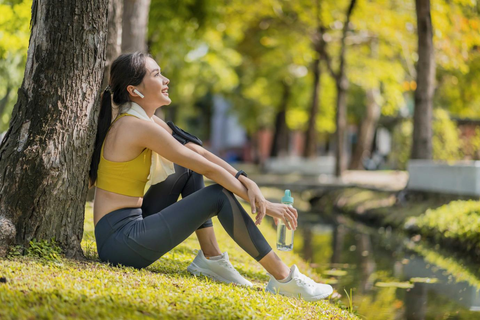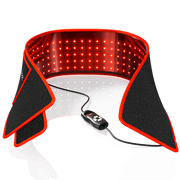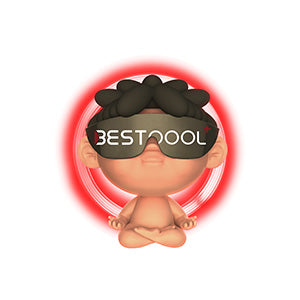Spring is the season of rejuvenation, sports, and fitness. As soon as spring arrives, the warm weather is very suitable for outdoor activities such as cycling, hiking, running, etc. One should also pay attention to their health when participating in outdoor activities. Outdoor activities could increase the risk of sunburn, allergies, insect bites, muscle sprains, etc. After the cold winter, the function of various organs in the body is at a low level, and the muscles and ligaments are relatively stiff. For some people who don't usually exercise, the muscle strength is relatively weak, and suddenly increasing the intensity of exercise can easily cause knee and ankle sprains. Add red light therapy to your spring outdoor activities bucket list to enhance your spring fitness goals.

What is Red Light Therapy?
Like water and food, our cells also need natural light energy to function optimally. Red light therapy, also called low-level laser therapy (LLLT), belongs to phototherapy, which utilizes visible red and near-infrared (660-850 nm) light to target mitochondria for therapeutic effects. The National Aeronautics and Space Administration (NASA) first used red light therapy to grow plants in space. Now, red light therapy has been widely used in the medical and aesthetic fields for wound healing, muscle repair, skincare, and relieving joint pain.
Red Light Therapy Benefits for Outdoor Activities Enthusiasts
- Post-Cycling Sunburn Relief
- Sunburn is a common outcome of prolonged outdoor activities in spring. The red light emitted by the device can penetrate the skin to a depth of 1-6mm. This deep penetration helps to reduce inflammation and promote skin repair, relieving discomfort and redness caused by sunburn. It stimulates collagen production in the skin. Collagen is essential for skin repair and recovery. Red light therapy can provide gentle warmth to the affected area, helping to soothe sun-damaged skin and reduce discomfort.
- Post-Jogging Muscles Recovery
- Jogging and cycling bring a risk of injury. Depending on the location, injuries can be very severe and may take longer to recover. Fortunately, studies have shown that red light therapy can help with this healing process, improving muscle performance and reducing pain. A studyon finding phototherapy efficacy reported that an LLLT of 830 nm application significantly relieved inflammation and pain in injured athletes. This treatment allows athletes to return to physical activity and training faster than usual to cope with musculoskeletal or soft tissue injuries. Experts recommend red light therapy to reduce arthritis and joint pain, heal muscle damage, and relieve post-exercise soreness.
- Energy Booster
- To stay consistent in a fitness routine, getting rid of fatigue and tiredness is a real struggle. Red and near-infrared light have analgesic properties that can reduce pain associated with musculoskeletal injuries and chronic conditions, allowing you to effectively manage and overcome discomfort. RLT has been shown to reduce pain and inflammation, alleviating conditions such as fatigue, muscle pain, and other painful conditions. Additionally, it boosts the serotonin neurotransmitter level, which energizes your body and mind.

Red Light Therapy Versus Traditional Methods for Recovery after Outdoor Activities
|
Criteria |
Traditional Methods |
Red Light Therapy |
|
Muscles Recovery |
Rest, icing, and massage therapy for muscle relaxation |
RLT deep cellular stimulation for rapid muscle recovery |
|
Skin Benefits |
Sunburn protection, possible tan |
Collagen production, reduced sunburn wrinkles, healing enhancement |
|
Side Effects |
Potential for burns, premature aging |
Minimal, if used correctly |
|
Usage Frequency |
Daily during sun exposure |
Regular sessions (e.g., 2-3 times a week) |
|
Duration of Effects |
Short-term (Protection lasts for hours) |
Long-term (Cumulative benefits) |
Incorporating Red Light Therapy into Daily Care
Integrating a red light therapy device into your daily wellness routine requires consideration of factors such as
- Best time to Use for Relaxation
- For fatigue removal, it is recommended to start using this red light therapy post-exercise in the evening. This is when our bodies naturally relax and prepare for sleep – a process that can be interrupted by exposure to other forms of light, such as blue or white light emitted by tech devices.
- Select the Right Equipment
- When buying the red light therapy device for your specific fitness needs, pay attention to factors such as wavelength options, power output, treatment area coverage, user-friendly design, and customization options. Choosing the right red light therapy is essential to get the best results. In addition, manufacturers should be FDA-approved to ensure product quality and compliance with regulatory standards.
- Safety Considerations
- While red light therapy may have potential benefits for fitness, it should not be used as a substitute for professional medical care. People with injuries should consult with a healthcare provider to determine the best treatment for their specific situation.
Conclusion
Combining red light therapy with outdoor exercise is a reliable, smart choice for both fitness and maintaining health. Its addition to daily care makes us no longer bothered by the health risks associated with outdoor sports. Overall, red light therapy provides spring fitness enthusiasts with a non-invasive and potentially effective way to improve performance, endurance, and recovery.
References and Citations
- Peserico, C. S., Zagatto, A. M., & Machado, F. A. (2019). Effects of Endurance Running Training Associated With Photobiomodulation on 5-Km Performance and Muscle Soreness: A Randomized Placebo-Controlled Trial. Frontiers in Physiology, 10.
https://doi.org/10.3389/fphys.2019.00211
- Ferraresi, C., Kaippert, B., Avcii, P., Huang, Y., Bagnatto, V. S., Parizotto, N. A., & Hamblin, M. R. (2015). Low level Laser light Therapy Increases Mitochondrial Membrane Potential and ATP Synthesis - C2C12 Myotubes with a Peak Response at 3–6 h. Photochemistry and Photobiology, 91(2), 411-416.
https://doi.org/10.1111/php.12397
- Borssa, P. A., Larkiin, K. A., & True, J. M. (2013). Does phototherapy increase skeletal muscle contractile function and post-exercise recovery? A systematic review. Journal of Athletic Training, 48(1), 57–67.
https://doi.org/10.4085/1062-6050-48.1.12
- Ferraresi, C., Huang, X., & Hamblin, M. R. (2016). Photobiomodulation in human muscle tissues: An advantage for sports performance? Journal of Biophotonics, 9(11-12), 1273-1299.
https://doi.org/10.1002/jbio.201600176
- Heiskannen, V., & Hamblin, M. R. (2018). Photobiomodulation: Lasers vs Light Emitting Diodes? Photochemical & Photobiological Sciences: Official Journal of the European Photochemistry Association and the European Society for Photobiology, 17(8), 1003. https://doi.org/10.1039/c8pp00176f














 Small
Small

 Moderate
Moderate

 Moderate
Moderate

 Moderate
Moderate

 Full
Full



